Abstract
The ventilation resistance of air flow through rice grain layers is one of the key parameters affecting drying uniformity as well as the energy consumption of the drying process. In order to reveal the variation of characteristics of the ventilation resistance with paddy grain moisture content, the air velocity and the bed layer depth are needed. A second order model was fitted to pressure drop using the response surface methodology and the results are compared with those of the Ergun model. The results showed that the pressure drop increases with the increase of paddy grain moisture content, air velocity and the bed layer depth, and the interactions between the air velocity and the bed layer depth have the most significant influence on the pressure drop. Moreover, a second-order polynomial pressure drop model based on RSM was established and compared with the Ergun model. The results showed that the pressure drop model established by RSM is similar to that of the Ergun model.
1. Introduction
The pressure drop of the grain bed layer is the key parameter for designing and optimizing the structure of the drying chamber, and it is also one of the most important references for selecting the power of a fan [1,2]. During the drying process, owing to the bed layer porosity as well as the air viscosity, there must be a pressure drop when the air flows through the bed layer. A high-pressure drop may make it difficult for the air to flow through the bed layer and further lead to the increase of non-uniformity of the drying process, while a low-pressure drop may lead to wasting the power of the fan [3]. Accordingly, it is necessary to find out a reasonable pressure drop under the premise of ensuring product quality and maintaining a reasonable power demand of the fan.
In the last few decades, researchers have done many studies on the ventilation resistance of the grain bed layer by applying the traditional pressure drop models [4,5,6,7]. For example, Gunasekaran and Jackson [8] conducted an experiment on the flow resistance of sorghum bed layer by applying the Ergun model, the resistance of sorghum moisture content of 16.5, 18.5, and 23 %w.b. were determined under the grain bed depth of 150 to 1200 mm with the airflow ranges of 0.05 to 0.3 m/s. The results showed that the resistance of airflow increases with the increase of air velocity and bed layer depth, while resistance increases with the decrease of moisture content. Li et al. [9] applied the Shedd model to simulate the flow resistance of the hot air flow through the paddy grain bed layer; they found that the flow resistance of the hot air increases with the increase of hot air velocities. Zhang et al. [10] investigated the pressure drop of the air (with velocity ranges of 0.1 to 0.6 m/s) flow through the bed layer with depth ranges of 100 to 1000 mm, and found that the simulation accuracy of the pressure drop using Ergun model is reliable only when the air velocity is under 0.2 m/s. It can be summarized from the above analyses that the flow resistance of the grain bed layer are mainly determined by the traditional models and the characteristics of the air flow resistance are investigated by using single factor test. Though the works provided some valuable references for guiding the practical production, the air flow resistance prediction accuracy based on traditional models should be further improved and the interaction of the parameters on the flow resistance should be further investigated.
Respond surface methodology (RSM) is one of the most effective modeling tools to investigate the interactions of two or more variables on the responses, which is widely adopted to optimize the process parameters in the agriculture field [11,12]. Zeng et al. [13] conducted an experimental study on the vacuum drying extraction technology of konjac glucomannan using RSM, and an artificial neuron network (ANN) was also adopted and then compared with the RSM. The results showed that the model established by RSM is slightly better than that of an ANN. In order to improve the dynamic performance of orchard ditching fertilizer and to avoid resonance, Liu et al. [14] adopted the RSM to optimize the structure of the rack of orchard ditching–fertilizer machine. The results showed that the optimized structure has a better first-order modal frequency of 38.31 Hz than that of the traditional structure, and the optimized frequency is far away from the input frequency (35 Hz) of a tractor, indicating that the frequency of the structure optimized by RSM can avoid the resonance. Moreover, Kowalczyk et al. [15] adopted the RSM to optimize the production process of a micro-elemental feed additive for laying hens, the most favorable enrichment conditions of the process were determined by the model established by the RSM. It can be summarized that the RSM is widely used in the agricultural field, and it can be also adopted to model the ventilation resistance of paddy grain layer.
The present work adopted the RSM to model the ventilation resistance of paddy grain layer. In detail, an experiment followed by Box–Behnken Design was conducted to investigate the influences of the independent variable including paddy grain moisture content (Mc), air velocity (vair), and paddy layer depth (L) on the pressure drop (Δp). The influences of the single factor as well as the interactions between any two independent variables on Δp were investigated and a ternary quadratic model for Δp was established and compared with the traditional Ergun model.
2. Materials and Methods
To fully understand the variation rules of ventilation resistance of the air flowing through paddy grain layer and further specify the optimization strategy for deep bed paddy drying process. A laboratory-scale experimental test was conducted based on the engineering application consideration; the detailed analysis steps are as follows.
2.1. Materials
The paddy grains sample with initial moisture content of 12.2 %w.b. are purchased from a local farmer at Leizhou Guangdong Province, China. The samples are, respectively manual humidified to 13.6 %w.b., 14.8 %w.b., 16.2 %w.b., 17.8 %w.b., 18.9 %w.b., 21.3 %w.b., 22.9 %w.b., 24.5 %w.b., and 25.6 %w.b. according to the methodology introduced in the literature [16]. Additionally, the prepared samples are sealed in plastic bags and stored in a refrigerator at approximately 4 °C for about 48 h prior to the experiments [13].
2.2. Experimental Apparatus
As can be seen from Figure 1, the apparatus mainly consists of 6 parts including the centrifugal fan, frequency converter, air supply duct, screen mesh, test pipeline, and the fixing bracket. There are 10 pressure taps with a diameter of 10 mm on the test pipeline, the height of the test pipeline is 1100 mm, and the distance between any two adjacent pressure taps is 100 mm. Moreover, there is one air velocity tap closed to connection between the test pipeline and air supply duct and the connection is sealed by a rubber ring and silicone [17]. During the tests, the three levels of air velocities (0.1, 0.35, and 0.6 m/s) are produced by the centrifugal fan connected with a frequency converter. The air flows through the air supply duct, then flows cross the screen mesh, further flows cross the grain layer, and finally flows into the ambient space. The vair was controlled by the frequency converter. The inlet vair was measured by an anemometer. The air pressure was measured by a digital pressure gauge. The details of the instruments used in the tests are tabulated in Table 1. Compared with the industrial dryer—although the physical structure of the laboratory-scale apparatus is different, the grain bed is dynamic (actually for a single grain bed layer, and the velocities of the grain bed are very low during the cyclic drying process—the ratio of air volume to the mass of the bed layer for the industrial dryer and the apparatus are the same [18]. This indicates that the main results obtained by the laboratory-scale apparatus can provide some references for the industrial dryer, especially for power selection of the fan and to ascertain of the bed layer depth in the design link of the industrial dryer.
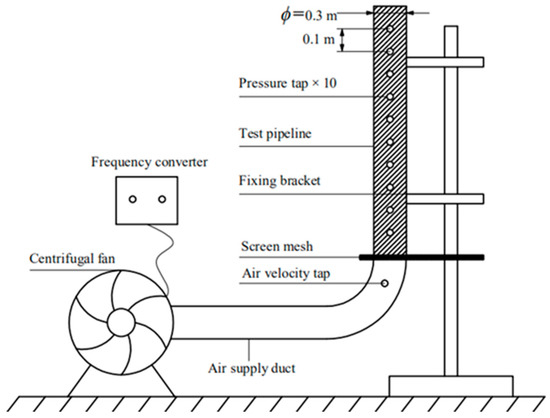
Figure 1.
The schematic diagram of the laboratory-scale experimental apparatus.

Table 1.
The details of the instruments used for the tests.
2.3. Experimental Design
2.3.1. RSM Design
In the present work, three different paddy grain Mc of 12.2 %w.b., 18.9 %w.b., and 25.6 %w.b.; three different vair of 0.10, 0.35, and 0.60 m/s; three different L of 0.10, 0.55, and 1.0 m, were considered to be the independent variables, while the Δp was regarded as the response. Owing to the fact that the Box–Behnken Design has the advantages of the less experimental operations comparing with Central Composite Design [19], and by comprehensive considering that the mass of each test is huge, the Box–Behnken Design method was adopted to analyze the effects of the interaction of independent variables (Mc, vair, and L) on the response (Δp) and further optimize the drying process. The experimental design representing the natural and coded values of independent variables are shown in Table 2. In order to develop the mathematical relations between the independent variables and the response, the second-order polynomial model (Equation (1)) was adopted to establish the RSM model [20].
where Y is the response, Xi and Xj are the independent variables affecting the response, β0, βi, and βij are the regression coefficients for intercept quadratic liner and interaction terms.

Table 2.
Experimental design for the RSM test.
2.3.2. Model Validation
In statistics, the p-value is the probability of obtaining results as extreme as the results observed from a statistical hypothesis test, assuming that the null hypothesis is correct. The p-value is used as an alternative to rejection points to provide the smallest level of significance where the null hypothesis would be rejected [21,22]. A smaller p-value means stronger evidence for the alternative hypothesis [23].
Based on the analysis above, the p-value is used to validate hypothesis test of the model. The null hypothesis is defined as the response (Δp) that cannot be explained by the obtained model, while the alternative hypothesis is defined as the response (Δp) can be explained by the obtained model.
2.3.3. RSM Model Validation Metrics
In the present work, the statistical indexes including determination coefficient (R2), mean absolute error (MAE), mean square error (MSE), and root mean square (RMSE) were adopted to evaluate the fitting performance of the Δp model developed by the RSM and the Ergun model, which can be, respectively, calculated followed by the following Equations (2)–(5) [24]:
where, Ypre,i is the value predicted by the models, Yexp,i is the experimental value,
exp is the mean of the experimental values, and n is the number of the data points. Moreover, the experimental results are tabulated in Table 3.

Table 3.
Experimental design for the tests.
2.3.4. ANOVA Validation: Anderson-Darling (AD) Test for Normality
According to some of the literature, the distribution of residuals for a set of data can reflect the validity of a predicted model [25]. In detail, if the residuals follow a normal distribution (occurrences are random), the established model has a well-predicting capacity. The Anderson–Darling (AD) test is the statistical tool used to quantify the deviation for a set of residuals from a normal distribution. The validity of the distribution of residuals in the AD test at a 5% level of significance was used to confirm the model accuracy and to determine if a sample data set was taken from a population with a specific distribution [26]. In the present work, the AD test was conducted by the software Minitab 17.0, the null hypothesis is defined as the distribution of the residuals that do not follow the normal distribution, and the hypothesis can be rejected if the test statistic (AD value) is greater than a critical value [27].
2.3.5. Single Factor Experiments
In order to investigate influence of each independent variable on the response, the Δp under ten levels of Mc, vair, and L were, respectively, measured followed by the 3 sets of experimental design, the single factor experiment design and the corresponding results are tabulated in Table 4.

Table 4.
Experimental design for the single factor tests.
2.4. Ergun Model
Ergun model is one of most effective tools for revealing the relationship between fluid properties and porous media properties, which has been widely used in Hydrodynamics, thermodynamics, and engineering [28]. In order to investigate the ventilation resistance characteristics of the air flow through the paddy bed layer as well as to verify the Δp model developed by the RSM. The most widely used Ergun model (ΔpEur) was applied in the present work, which can be expressed as following expressions [29,30,31]:
where μ is the dynamic viscosity of the air, 1.81 × 10−5 kg/(m·s) [32]; ρ is the density of the air, ρ = 1.205 kg/m3 [33]; ε is the porosity of the bed layer; and dg is the equivalent diameter of a single paddy grain, m. The ε for different Mc levels of the paddy grains can be determined by a self-developed porosimeter; the details of the porosimeter can be found in our previous work [34].
On the other hand, the dg for a single paddy grain with different Mc can be calculated according to the length (L0), width (W0), and height (H0) of the paddy grain. The calculation methodology introduced by Mohsenin et al. [35] are expressed as follows:
Each parameter used for calculating the dg was measured 3 times and the average value was used for the calculation. The dg and ε for different Mc used for calculation in the Ergun model are shown in Figure 2.
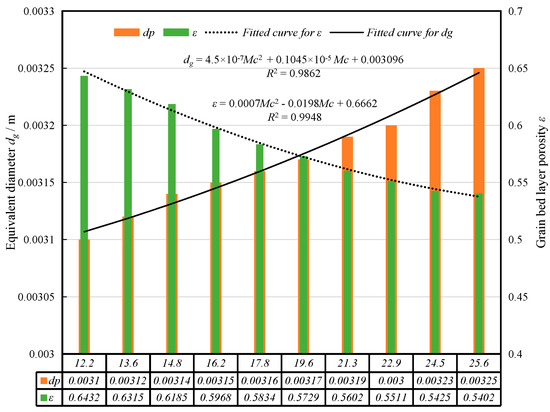
Figure 2.
The variations of the dg and ε with Mc.
3. Results
3.1. ANOVA Analysis
In the present work, the software Design Expert 8.0.6 was applied to analyze the experimental results and the ANOVA analysis was employed to analyze the significance of the Mc, vair, and L on the Δp. The results are tabulated in Table 5. It can be seen from the table that the sum of squares, mean square, F-value, and p-value for each of the terms of the model were calculated, of which the F-value and p-value are the criteria for evaluating the fitting performance of the specific term [36]. Specifically, the larger the F-value is, the more significant the term is and the better the fitting performance is; on the other hand, the p-value with the range of (0.01 < p < 0.05) indicates the term is significant (characterized by the symbol “*”) while a p-value less than 0.01 indicates that the term is extremely significant (characterized by the symbol “**”).

Table 5.
ANOVA evaluation of linear, quadratic, and interaction terms for response and coefficient of Δp model.
As can be seen from Table 5, the Δp model F value of 148.56 corresponds to a low p-value (p < 0.0001), which implies that the model was significant as the test failed to accept the null hypothesis that variations in the response could not be explained by the model. This indicates that the Δp model developed by the RSM is significant, and the experimental Δp can be explained by the obtained model. Moreover, the values of R2, Adj R2, and Pred R2 are similar and all close to 1 [37], which also indicates that the Δp model is in a well-fitting performance and can be used to predicted the Δp. The value of the C.V.% term is 10.98%, indicating that there are only 10.98% of the experimental data that cannot be explained by the Δp model developed by the RSM, in statistics, if the value of the C.V.% is greater than 15%, the data may be abnormal and should be eliminated [19]. On the other hand, the predicted residual sum of squares (PRESS) is a measure of how well the Δp model fits each point in the design. The high PRESS value (35358.41) in the present work may be caused by the abnormal 10.98% data. The influences of Mc, vair, and L on the Δp model can be determined by the F-value as well as the p-value. It can be obviously summarized that the terms of Mc, vair, L, Mc·vair, Mc·L, vair·L, and vair2 have significant influences on the Δp while the Mc2 and L2 have no influence on the Δp. For the significant terms, by estimating the corresponding F-value, the contributors to the Δp, in ascending order of significance, are as follows: vair2, Mc·vair, Mc·L, Mc, vair·L, L, and vair.
3.2. Anderson-Darling Normality Test Results
In the present work, the residuals are the difference between the experimental Δp and the predicted Δp by the established model (Equation (2)). The AD test was conducted by the software Minitab 17.0, and the probability distribution plot of the residuals is shown in the following Figure 3. As can be seen from the figure, the obtained AD value (0.484) is less than a critical value of 0.752, and the associated p-value (0.594) of the AD test is significant at a 5% level (p-value > 0.05) [25]. The results indicate that the residuals follow a normal distribution, and the deviation between the experimental Δp and predicted Δp are random [26]. Accordingly, it can be concluded that the null hypothesis can be rejected and the model predictions are correlated with the experimental data over the factor-space under evaluation in the present work.
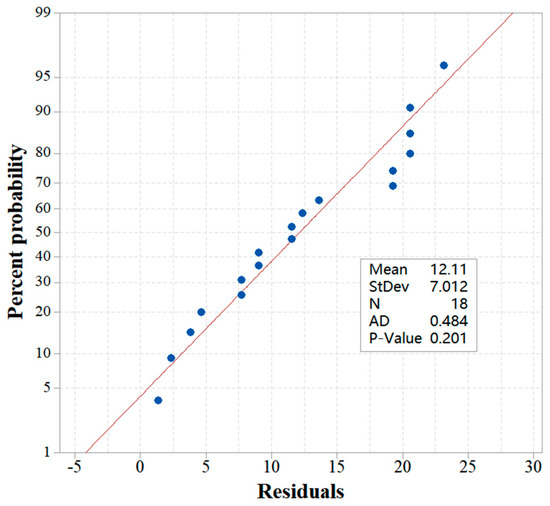
Figure 3.
The results of the Anderson–Darling normality test.
3.3. The Interactions of the Independent Variables on the Pressure Drop
Based on the ANOVA analysis in Section 3.1, the Mc·vair, Mc·L, and vair·L, respectively, have significant influences on the Δp. The response surface as well as its corresponding contour plots are depicted in the following Figure 4, Figure 5 and Figure 6. As can be seen from Figure 4a, the Δp increases with the increase of vair under constant Mc, which might be due to the fact that the inertia resistance of the air increases with the increase of vair, just as reported by Zhang et al. [10]. On the other hand, the Δp increases with increase of Mc under constant vair, which might be caused by the increased ε in high Mc, just as reported by Li et al. that the ε of paddy layer increases with increase of paddy moisture content [38]. Though the suitable Δp for the engineering application should be further investigated by comprehensively considering the power of the fan, the contours shown in Figure 4b can be the reference for the single factor analysis.
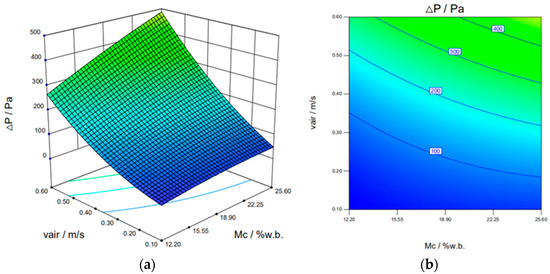
Figure 4.
The interaction of Mc and vair on the Δp (a) and the contour plots (b).
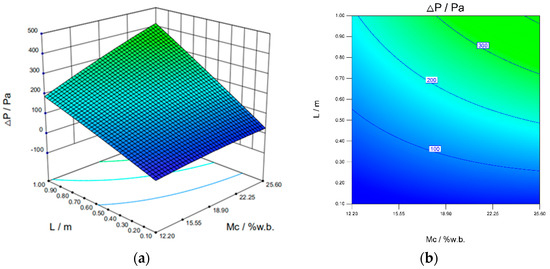
Figure 5.
The interaction of Mc and L on the Δp (a) and the contour plots (b).
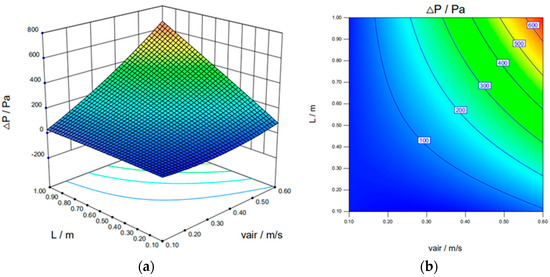
Figure 6.
The interaction of vair and L on the Δp (a) and the contour plots (b).
Figure 5 depicts the interaction of Mc and L on the Δp, similar with the trend shown in above Figure 4. Δp increases with increase of L, which might be caused by the fact that the path of air flow through the paddy grain layer increases with the increase of L and further lead to the increase of Δp; a similar finding has been reported by Rocha et al. for Δp of paddy rice layer [39]. On the other hand, the Δp increases with increase of Mc; the same reason analyzed in Figure 4 can be also used to explain the trend. Interestingly, the Δp under different Mc with the L under 0.4 m almost remains constant, indicating that the Δp is slightly affected by the Mc when the L is small, which can be regarded as a design reference of the bed layer depth. Moreover, it can be seen from Figure 5a that the Δp linearly varies the single factor L or Mc, while the Δp non-linearly varies with the interaction terms of Mc·L, just as shown in the following Figure 5b.
The interaction of vair and L on the Δp are shown in the following Figure 6. As can be seen from Figure 6a that the Δp varies from the minimum 17.11 Pa to the maximum 689.56 Pa, the variation range is much larger than that of the interaction terms of Mc·L and Mc·vair, indicating that the influence of term L·vair on Δp is more significant than that of Mc·L and Mc·vair, just as analyzed in Section 3.1. Accordingly, in order to reach the objective of the efficient and energy-saving drying, efforts should be firstly made to optimize the drying parameters related to the L and vair in the engineering drying application. Especially when the air with high vair flow through the bed layer with large L, the Δp rapidly increases with the interaction term of L·vair (as shown in Figure 6b, in other words, the larger driven force for supplying the drying medium is needed when the L·vair is high.
3.4. The Comparison of the Δp Model Developed by RSM and Ergun Model
In order to verify the feasibility of the Δp model developed by RSM, the comparison analysis focused on the RSM experiments for the Δp model developed by RSM and Ergun model was conducted, and the statistical indexes including R2, MAE, MSE, and RMSE were calculated. The detailed analysis is in Section 3.4.1.
3.4.1. The Comparison of the Δp in the RSM Experiments
Based on the ANOVA analysis results shown in Table 5, the second-order polynomial expression of the Δp model developed by the RSM (ΔpRSM) are expressed as following Equation (8):
The 17 sets of independent variables tabulated in Table 5 were substituted into the above ΔpRSM model and the predicted ΔpRSM values were obtained. On the other hand, the 17 sets of independent variables were also substituted into the ΔpEur model shown in Equation (2) by transmitting the Mc into the corresponding ε (just as tabulated in Figure 2), and the predicted ΔpEur values were obtained and compared with the corresponding predicted ΔpRSM. The comparison between the ΔpRSM and the ΔpEur were evaluated by the validation metrics (Equations (2)–(5)), and the statistical results are tabulated in Table 6.

Table 6.
The statistical results of the RSM experiment for comparing ΔpRSM and ΔpEur.
As can be seen from Table 6, the index R2 (0.9948) of the RSM model is higher than that of the Ergun model (0.9868), while the indexes MAE, MSE, and RMSE of the RSM model are, respectively, lower than the corresponding index of the Ergun model, which indicates that the pressure drop model developed by the RSM is better fitted than the Ergun model.
3.4.2. The Single Factor Analysis of the Δp
In order to validate fitting performance of the ΔpRSM and ΔpErg. The second-order polynomial RSM model was transmitted into three first-order quadratic models by substituting the independent variables shown in Table 3 into Equation (8), the single factor pressure drop models based on the ΔpRSM are as follows:
Based on the above Equations (6), (9)–(11), the variations of Δp with Mc, vair, and L can be obtained and, respectively, depicted in the following Figure 7, Figure 8 and Figure 9. As can be seen from Figure 7 that the Δp is proportional to the Mc, and the variation range of the Δp was ascertained to be 86.38–197.57 Pa. It can be summarized from Figure 2 that the equivalent diameter dg increases with the Mc while porosity of the bed layer ε decreases with the increase of the Mc, indicating that the volume of the air pathways decreased with the increase of Mc [40], and further lead to the flow resistance of the air passing through the bed layer will be increased with the increase of the Mc. On the other hand, it can be seen from Figure 7 that the ΔpRSM are more closed to the experimental Δp than the ΔpErg.
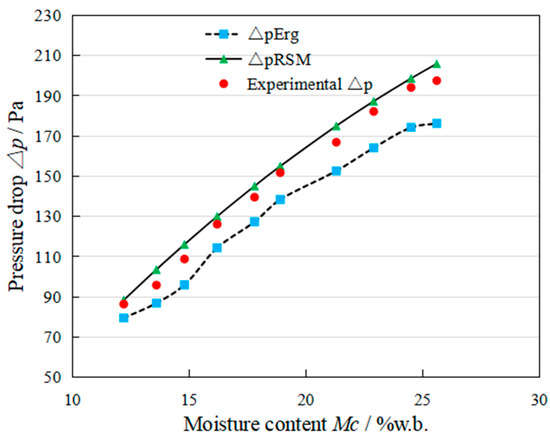
Figure 7.
The variations of Δp with Mc under the constant vair of 0.35 m/s and L of 0.5 m.

Figure 8.
The variations of Δp with vair under the constant Mc of 18.9 %w.b. and L of 0.5 m.
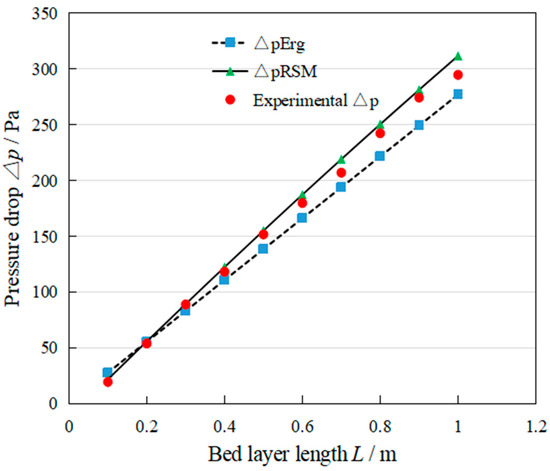
Figure 9.
The variations of Δp with L under the constant vair of 0.35 m/s and Mc of 18.9 %w.b.
Figure 8 depicts the variations of Δp with vair under the constant Mc of 18.9 %w.b. and L of 0.5 m. Similar with the variation trend of the Δp shown in the above Figure 7, Δp also increases with increase of vair, and the variation range of the Δp was ascertained to be 38.44–352.92 Pa. Moreover, it can be seen from Figure 8 that the ΔpErg with the vair of 0.1 m/s and 0.15 m/s are more closed to the corresponding experimental Δp than the ΔpRSM, indicating that the Ergun model has a better prediction performance than the developed RSM model when the vair is under 0.2 m/s. The same conclusions have been made by Mahmood et al. [41] and Ye et al. [10]. However, in this case, the developed ΔpRSM model has a better performance than the Ergun model when the vair is above 0.2 m/s, which may be more suitable for guiding the actual process.
The variations of Δp with L under the constant vair of 0.35 m/s and Mc of 18.9 %w.b. are depicted in Figure 9. It can be seen from the figure that the Δp linearly increases with the increase of L, and the Δp gets the minimum (27.68 Pa) and maximum value (276.83 Pa), respectively, at the L of 0.1 and 1m. On the other hand, it can be also seen from Figure 9 that, for the all levels of L, the fitting performance of the ΔpRSM is better than that of the ΔpErg. In order to further investigate the fitting performance of the ΔpRSM and the ΔpErg in the above three single factor experiment, the statistical indexes mentioned in Section 2.3.3 were also calculated and the results are tabulated in the following Table 7.

Table 7.
The statistical results for the single factor experiments.
As can be seen from Table 7 that the R2 value of each single factor model based on the ΔpRSM is higher than that of the corresponding model based on the ΔpErg, while the other indexes (MSE, MAE, and RMSE) of each single factor model based on the ΔpRSM are lower than the corresponding index of the corresponding model based on the ΔpErg. Which indicates that the single factor model ΔpMc, Δpvair, and ΔpL based on the ΔpRSM has better fitting performance than that of the corresponding single factor model based on the ΔpErg. By combining the results obtained in Section 3.4.1, it can be concluded that the developed ventilation resistance model based on the RSM has a better predicting performance than the traditional Ergun model.
4. Conclusions
By considering the moisture content (Mc), air velocity (vair), and grain bed layer depth (L) as the key factors affecting the ventilation resistance of the air, one must regard the pressure drop (Δp) as the key index characterizing the ventilation resistance of the air. The present work investigated the influences of each factor and the interactions of the factors on the pressure drop; a second-order polynomial model was also obtained based on the RSM. The detailed conclusions depending on the main results are listed as follows:
- (1)
- The relations among the Mc, ε, and dg were revealed and the mathematical expressions were also given in the present work.
- (2)
- The Δp increases with the increase of Mc, vair, and L and the contributors to the Δp, in ascending order of significance, are as follows: Mc < L < vair.
- (3)
- The interaction analysis indicates that the interactions of the vair and L has the most significant influence on the Δp, and the match principle between the vair and L should be firstly considered when optimizing the drying process.
- (4)
- A second-order polynomial Δp model based on the RSM was obtained, and its fitting performance was verified to be better than that of the traditional Ergun model by evaluating the R2, MSE, MAE, and RMSE.
- (5)
- The developed Δp model based on the RSM shows a better fitting performance than the Ergun model when the vair ≥ 0.2 m/s, while the Ergun model shows better when the vair is under 0.2 m/s.
The present work revealed the influences of the variables that can be directly measured in an engineering drying application on the pressure drop and established a prediction model of the pressure drop. Thus, the main results would be helpful for further optimizing the drying process. Further study is recommended to investigate the pressure drop variation characteristics by taking the air temperature as well as the paddy grain flow velocity into consideration.
Author Contributions
Conceptualization, X.W. and C.H.; methodology, X.W. and C.H.; software, X.W, T.H. and C.H.; validation, X.W., T.H. and C.H.; formal analysis, X.W. and J.X.; investigation, X.W., Z.Z. (Zhiheng Zeng) and T.T.; resources, X.W. and Z.Z. (Zhiheng Zeng); data curation, X.W.; writing—original draft preparation, X.W.; writing—review and editing, X.W.; visualization, X.W, Z.Z. (Zefeng Zheng) and T.T.; supervision, W.W.; project administration, W.W.; funding acquisition, W.W. All authors have read and agreed to the published version of the manuscript.
Funding
This research was funded by the Key Realm R&D Program of Guangdong Province (2019B020214001, 2019B020223001), Guangdong Provincial Special Fund for Modern Agriculture Industry Technology Innovation Teams (No. 2020KJ120-CJXG), and China Agriculture Research System (CARS-26).
Institutional Review Board Statement
Not applicable.
Informed Consent Statement
Not applicable.
Acknowledgments
The authors would like to thank the editors and reviewers for their valuable and constructive comments.
Conflicts of Interest
The authors declare no conflict of interest.
References
- Mujumdar, A.S. Handbook of Industrial Drying, 3rd ed.; Taylor & Francis Group: Abingdon, UK; CRC Press: Boca Raton, FL, USA, 2006. [Google Scholar] [CrossRef]
- Li, C. Theoretical analysis of exergy transfer and conversion in grain drying process. Trans. Chin. Soc. Agric. Eng. 2018, 34, 1–8. [Google Scholar] [CrossRef]
- Li, J.; Li, C.; Ma, X. Experimental study on ventilation resistance of paddy. Guangdong Agric. Sci. 2012, 39, 191–193. [Google Scholar] [CrossRef]
- Chu, J.C.; Teng, J.T.; Xu, T.T.; Huang, S.; Jin, S.; Yu, X.F. Characterization of frictional pressure drop of liquid flow through curved rectangular microchannels. Exp. Therm. Fluid Sci. 2012, 38, 171–183. [Google Scholar] [CrossRef]
- Norouzi, A.M.; Siavashi, M.; Soheili, A.R.; Oskouei, M.H.K. Experimental investigation of effects of grain size, inlet pressure and flow rate of air and argon on pressure drop through a packed bed of granular activated carbon. Int. Commun. Heat Mass Transf. 2018, 96, 20–26. [Google Scholar] [CrossRef]
- Spieler, O.; Alidibirov, M.; Dingwell, D.B. Grain-size characteristics of experimental pyroclasts of 1980 mount st. helens cryptodome dacite: Effects of pressure drop and temperature. Bull. Volcanol. 2003, 65, 90–104. [Google Scholar] [CrossRef]
- Yue, R.; Zhang, Q. A pore-scale model for predicting resistance to airflow in bulk grain. Biosyst. Eng. 2017, 155, 142–151. [Google Scholar] [CrossRef]
- Gunasekaran, S.; Jackson, C.Y. Resistance to airflow of grain sorghum. Trans. ASAE 1988, 31, 1237–1240. [Google Scholar] [CrossRef]
- Li, Q.T.; Hu, T.Q.; Yu, Z.; Yang, Y.Q.; Fang, Y.L. Experimental study of fluid drag in granary ventilation. J. Hydrodyn. (Ser. A) 2006, 21, 473–478. [Google Scholar]
- Zhang, Y.; Li, C.; Ma, X.; Li, J.; Zou, X.; Wang, R. Experiment and Numerical Simulation of Layer Resistance Parameters in Dryer. Trans. Chin. Soc. Agric. Mach. 2014, 45, 216–221. [Google Scholar] [CrossRef]
- Li, B.; Peng, G.; Luo, C.; Qiu, G.; Yang, L. Optimization of rapeseed vacuum drying technology parameter by response surface methodology. Food Ferment. Ind. 2016, 42, 105–110. [Google Scholar] [CrossRef]
- Wang, X.; Wu, Y.; Chen, G.; Yue, W.; Liang, Q.; Wu, Q. Optimisation of ultrasound assisted extraction of phenolic compounds from sparganii rhizoma with response surface methodology. Ultrason. Sonochem. 2013, 20, 846–854. [Google Scholar] [CrossRef]
- Zeng, Z.; Chen, M.; Wang, X.; Wu, W.; Zheng, Z.; Hu, Z.; Ma, B. Modeling and Optimization for Konjac Vacuum Drying Based on Response Surface Methodology (RSM) and Artificial Neural Network (ANN). Processes 2020, 8, 1430. [Google Scholar] [CrossRef]
- Liu, S.; Zhang, H.; Wang, J.; Zhang, C.; Sun, L.; Qi, W. Optimization design of fertilizer-guiding mechanism for orchard ditching and fertilizing machin. J. Chin. Agric. Mech. 2017, 38, 45–53. [Google Scholar] [CrossRef]
- Kowalczyk, P.; Ligas, B.; Skrzypczak, D.; Mikula, K.; Chojnacka, K. Biosorption as a method of biowaste valorization to feed additives: Rsm optimization. Environ. Pollut. 2020, 268, 115937. [Google Scholar] [CrossRef] [PubMed]
- Sander, A.; Kardum, J.P.; Skansi, D. Transport properties in drying of solids. Chem. Biochem. Eng. Q. 2000, 15, 131–137. [Google Scholar] [CrossRef]
- Brzinski, T.A., III; Mayor, P.; Durian, D.J. Depth-dependent resistance of granular media to vertical penetration. Phys. Rev. Lett. 2013, 111, 168002. [Google Scholar] [CrossRef] [Green Version]
- Yang, Z.; Luo, X.; Li, C. Study on optimal ratio of air flux to grain mass for rough rice drying. Trans. Chin. Soc. Agric. Mach. 2007, 38, 122–125. [Google Scholar] [CrossRef]
- Jiang, H.; Yang, L.; Xing, X.; Yan, M.; Guo, X.; Yang, B.; Wang, Q.; Kuang, H. Chemometrics coupled with UPLC-MS/MS for simultaneous analysis of markers in the raw and processed Fructus Xanthii, and application to optimization of processing method by BBD design. Phytomedicine 2018, 57, 191–202. [Google Scholar] [CrossRef] [PubMed]
- Gupta, M.K.; Sehgal, V.K.; Arora, S. Optimization of drying process parameters for cauliflower drying. J. Food Sci. Technol. 2013, 5, 62–69. [Google Scholar] [CrossRef] [PubMed] [Green Version]
- Mhe, A.; Mhh, A.; Shr, B. Multi-objective particle swarm optimization of thermal conductivity and dynamic viscosity of magnetic nanodiamond-cobalt oxide dispersed in ethylene glycolusing RSM. Int. Commun. Heat Mass Transf. 2020, 117, 104760. [Google Scholar] [CrossRef]
- Aflaki, S.; Memarzadeh, M. Using two-way anova and hypothesis test in evaluating crumb rubber modification (crm) agitation effects on theological properties of bitumen. Constr. Build. Mater. 2011, 25, 2094–2106. [Google Scholar] [CrossRef]
- Cdd, A.; Yntn, A.; Dlt, B.; Quan, N.; Dcnb, C.; Long, G. Extraction conditions of polyphenol, flavonoid compounds with antioxidant activity from veronia amygdalina del. leaves: Modeling and optimization of the process using the response surface methodology rsm. Mater. Today: Proc. 2019, 18, 4004–4010. [Google Scholar] [CrossRef]
- Chokphoemphun, S.; Chokphoemphun, S. Moisture content prediction of paddy drying in a fluidized-bed drier with a vortex flow generator using an artificial neural network. Appl. Therm. Eng. 2018, 145, 630–636. [Google Scholar] [CrossRef]
- Konwarh, R.; Misra, M.; Mohanty, A.K.; Karak, N. Diameter-tuning of electrospun cellulose acetate fibers: A Box–Behnken design (BBD) study. Carbohydr. Polym. 2013, 92, 1100–1106. [Google Scholar] [CrossRef] [PubMed]
- Myer, R.H.; Montogomery, D.C. Response Surface Methodology: Process and Product Optimization Using Designed Experiment, 2nd ed.; John Wiley & Sons: New York, NY, USA, 2002; pp. 343–350. [Google Scholar]
- Box, G.E.P.; Draper, N.R. Empirical Model Building and Response Surfaces; John Wiley & Sons: New York, NY, USA, 1987; pp. 205–477. [Google Scholar]
- Huang, W.; Luo, Z.; Zhuang, H. Pressure drop calculation model of air dense-medium fluidized bed. Coal Eng. 2014, 46, 117–119. [Google Scholar] [CrossRef]
- Vicente, P.G.; Garcia, A.; Viedma, A. Mixed convection heat transfer and isothermal pressure drop in corrugated tubes for laminar and transition flow. Int. Commun. Heat Mass Transf. 2004, 31, 651–662. [Google Scholar] [CrossRef]
- Sieder, E.N.; Tate, G.E. Heat transfer and pressure drop of liquids in tubes. Ind. Eng. Chem. 1936, 28, 1429–1435. [Google Scholar] [CrossRef]
- Sarker, M.S.H.; Ibrahim, M.N.; Aziz, N.A. Energy and rice quality aspects during drying of freshly harvested paddy with industrial inclined bed dryer. Energy Convers. Manag. 2014, 77, 389–395. [Google Scholar] [CrossRef]
- Li, B.; Li, C.; Li, T.; Zeng, Z.; Ou, W.; Li, C. Exergetic, Energetic, and Quality Performance Evaluation of Paddy Drying in a Novel Industrial Multi-Field Synergistic Dryer. Energies 2019, 12, 4588. [Google Scholar] [CrossRef] [Green Version]
- Li, C.; Fang, Z.; Mai, Z. Design and Test on Porosimeter for Particle Material. Trans. Chin. Soc. Agric. Mach. 2014, 45, 200–206. [Google Scholar] [CrossRef]
- Li, T.; Li, C.; Li, C.; Xu, F.; Fang, Z. Porosity of flowing rice layer: Experiments and numerical simulation. Biosyst. Eng. 2019, 179, 1–12. [Google Scholar] [CrossRef]
- Aghbashlo, M.; Mandegari, M.; Tabatabaei, M.; Farzad, S.; Soufiyan, M.M.; Görgens, J.F. Exergy analysis of a lignocellulosic-based biorefinery annexed to a sugarcane mill for simultaneous lactic acid and electricity production. Energy 2018, 149, 623–638. [Google Scholar] [CrossRef]
- Erbay, Z.; Icier, F. Optimization of hot air drying of olive leaves using response surface methodology. J. Food Eng. 2009, 91, 533–541. [Google Scholar] [CrossRef]
- Dalvand, M.J.; Mohtasebi, S.S.; Rafiee, S. Modeling of electrohydrodynamic drying process using response surface methodology. Food Sci. Nutr. 2014, 2, 200–209. [Google Scholar] [CrossRef] [PubMed]
- Li, C.; Mai, Z.; Fang, Z. Analytical study of grain moisture binding energy and hot air drying dynamics. Trans. Chin. Soc. Agric. Eng. 2014, 30, 236–242. [Google Scholar] [CrossRef]
- Rocha, J.C.D.; Pohndorf, R.S.; Meneghetti, V.L.; de Oliveira, M.; Elias, M.C. Effects of mass compaction on airflow resistance through paddy rice grains. Biosyst. Eng. 2020, 194, 39. [Google Scholar] [CrossRef]
- Yang, Y.Q.; Yu, Z. Experimental Study of Grain Physics and Grain Bulk Resistance. Res. Explor. Lab. 2008, 27, 32–34. [Google Scholar] [CrossRef]
- Bazmi, M.; Hashemabadi, S.H.; Bayat, M. Modification of ergun equation for application in trickle bed reactors randomly packed with trilobe particles using computational fluid dynamics technique. Korean J. Chem. Eng. 2011, 28, 1340–1346. [Google Scholar] [CrossRef]
Publisher’s Note: MDPI stays neutral with regard to jurisdictional claims in published maps and institutional affiliations. |
© 2021 by the authors. Licensee MDPI, Basel, Switzerland. This article is an open access article distributed under the terms and conditions of the Creative Commons Attribution (CC BY) license (https://creativecommons.org/licenses/by/4.0/).